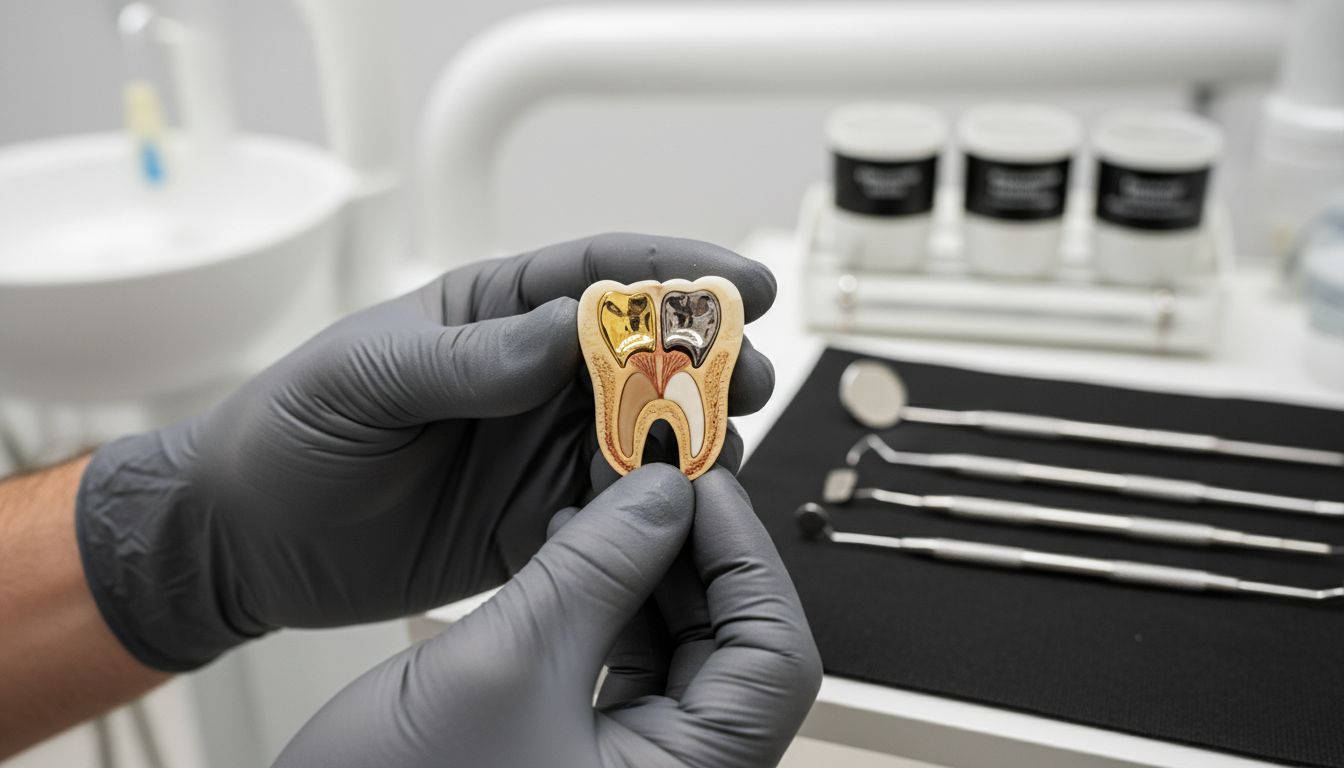
Did you know that nearly 90 percent of adults will get at least one cavity in their lifetime? Dental fillings play a vital role in repairing this damage and keeping natural teeth strong. When left untreated, tooth decay can lead to pain and major dental work. By understanding how fillings work and the choices available, you gain more control over your dental health and can keep your smile healthier for longer.
Table of Contents
- What Are Dental Fillings? Core Concepts Explained
- Common Types of Dental Fillings Compared
- Key Features of Filling Materials
- Cost, Durability, and Aesthetic Considerations
- Risks, Allergies, and Maintenance Tips
- Alternatives to Dental Fillings and When to Consider Them
Key Takeaways
| Point | Details |
|---|---|
| Fillings Purpose | Dental fillings restore teeth damaged by decay and prevent further deterioration. They act as protective barriers to maintain the tooth’s strength. |
| Material Choices | Common filling materials include gold, amalgam, composite resin, and ceramic, each with unique durability, cost, and aesthetic properties. Selecting the right material depends on the cavity’s location and patient preferences. |
| Allergic Reactions | Patients should discuss their medical history with their dentist, particularly regarding potential mercury allergies related to amalgam fillings. |
| Alternatives to Fillings | When damage exceeds standard fillings, options like dental crowns and inlays/onlays should be considered for more extensive structural support. |
What Are Dental Fillings? Core Concepts Explained
Dental fillings are specialized materials used to restore teeth damaged by decay, essentially rescuing a tooth from further deterioration. According to the National Institute of Dental and Craniofacial Research, the procedure involves carefully removing decayed tooth tissue and filling the space to protect the tooth’s structural integrity and restore its full functionality.
The primary purpose of dental fillings is to stop tooth decay from progressing and prevent additional damage. By sealing off the area where bacteria could potentially enter, fillings act as a protective barrier that maintains the tooth’s strength and prevents future complications. Understanding why teeth hurt can help patients recognize when they might need this crucial dental intervention.
Most dental fillings are composed of two primary types of materials: metal amalgams and composite resins. These materials serve different purposes and offer unique advantages. Metal fillings are typically more durable and cost-effective, while composite resins provide a more natural appearance that blends seamlessly with your existing tooth color. Dentists carefully select the most appropriate filling based on the location of the cavity, the extent of tooth decay, and the patient’s specific dental health needs.
Common Types of Dental Fillings Compared
According to WebMD, dental fillings come in several primary materials, each with unique characteristics that make them suitable for different dental needs. The most common types include gold, porcelain, silver amalgam, composite resin, and glass ionomer. Understanding the pros and cons of each material helps patients make informed decisions about their dental restoration.
The Cleveland Clinic distinguishes between two fundamental categories of dental fillings: direct and indirect. Direct fillings like amalgam and composite resin are placed immediately into the cavity during a single dental visit. These fillings are typically more affordable and require less preparation time. In contrast, indirect fillings such as inlays and onlays are custom-fabricated outside the mouth and then precisely bonded to the tooth, offering a more tailored approach to tooth restoration.
Each filling type offers distinct advantages.
 Gold fillings are incredibly durable and can last decades, though they are the most expensive. Porcelain fillings provide excellent aesthetic matching but are more fragile. Silver amalgam is cost-effective and robust, while composite resins offer the best cosmetic result by blending seamlessly with natural tooth color. 7 Most Common Dental Treatments You Should Know can provide additional context about these restoration techniques and help patients understand their options more comprehensively.
Gold fillings are incredibly durable and can last decades, though they are the most expensive. Porcelain fillings provide excellent aesthetic matching but are more fragile. Silver amalgam is cost-effective and robust, while composite resins offer the best cosmetic result by blending seamlessly with natural tooth color. 7 Most Common Dental Treatments You Should Know can provide additional context about these restoration techniques and help patients understand their options more comprehensively.
When selecting a dental filling, dentists consider multiple factors including the location of the cavity, patient’s budget, aesthetic preferences, and the extent of tooth decay. Some patients might prioritize durability, while others focus on a natural appearance. The right choice depends on individual dental health needs and personal preferences.
Key Features of Filling Materials
According to WebMD, different dental filling materials come with unique characteristics that significantly impact their performance and longevity. Gold fillings stand out for their exceptional durability, potentially lasting over 15 years, but come with a higher price tag and require multiple dental visits for proper installation. In contrast, composite resins offer a more aesthetically pleasing solution by matching natural tooth color, though they tend to wear out more quickly compared to other materials.
Ceramic fillings present an intriguing option for patients prioritizing both appearance and durability. As research from Fairview Dental Clinic reveals, these tooth-colored fillings are not only stain-resistant but can also last over 15 years. However, they typically involve removing more tooth structure during installation and come with a higher cost, which patients should carefully consider.
The key features of filling materials can be compared across several critical dimensions:
Here’s a comparison of the main dental filling materials:
| Material | Durability | Cost | Aesthetics |
|---|---|---|---|
| Gold | 15+ years | Highest | Noticeable metal |
| Amalgam (Silver) | 10-15 years | Most affordable | Noticeable metal |
| Composite Resin | 5-7 years | Moderate | Tooth-colored |
| Ceramic (Porcelain) | 15+ years | High | Tooth-colored |
| Glass Ionomer | 5 years | Moderate | Tooth-colored |
- Durability: Gold and ceramic materials offer the longest lifespan
- Cost: Silver amalgam and composite resins are more budget-friendly
- Aesthetics: Ceramic and composite resins provide the most natural appearance
- Tooth Preservation: Some materials require more tooth structure removal than others
Understanding Dental Implants vs Dentures can provide additional context about dental restoration options, helping patients make more informed decisions about their oral health treatments. Ultimately, the ideal filling material depends on individual needs, budget, and the specific condition of the tooth requiring restoration.
Cost, Durability, and Aesthetic Considerations
According to WebMD, the decision to choose a dental filling involves carefully balancing three critical factors: cost, durability, and aesthetic appeal. Gold fillings represent the premium option, offering exceptional longevity by potentially lasting over 15 years, but coming with a significantly higher price tag that might strain many patients’ budgets. Composite fillings, in contrast, provide a more affordable and visually appealing solution that seamlessly blends with natural tooth color.
Fairview Dental Clinic’s research highlights the trade-offs between different filling materials. Amalgam fillings emerge as the most cost-effective option, demonstrating remarkable durability but falling short in aesthetic considerations due to their metallic appearance. Composite resins offer the best cosmetic result, matching natural tooth color perfectly, but at the expense of reduced longevity and higher cost compared to traditional amalgam options.
To help patients make informed decisions, here’s a quick comparison of filling materials:
- Gold Fillings: Maximum durability, highest cost
- Amalgam Fillings: Most budget-friendly, good durability, poor aesthetics
- Composite Resins: Excellent aesthetics, moderate cost, shorter lifespan
- Ceramic Fillings: Superior aesthetics, high durability, premium pricing
Choosing Dental Insurance in Edmonton can help patients manage the financial aspects of dental treatments. Ultimately, the best filling material depends on individual priorities, whether that’s long-term durability, immediate cost-effectiveness, or maintaining a natural-looking smile.
Risks, Allergies, and Maintenance Tips
According to WebMD, dental fillings can present potential health considerations that patients should carefully understand. Mercury allergies are a significant concern with amalgam fillings, as some individuals may experience adverse reactions to the metallic components. These allergic responses can manifest as localized inflammation, skin rashes, or more systemic immune reactions, making it crucial for patients to discuss their medical history thoroughly with their dentist before selecting a filling material.
Fairview Dental Clinic’s research highlights that composite fillings may cause temporary tooth sensitivity following the procedure. This sensitivity typically occurs as the tooth adjusts to the new filling and can be managed through proper oral care techniques. Patients are advised to avoid extremely hot or cold foods and practice gentle brushing during the initial healing period.
To ensure long-term dental health, consider these maintenance tips:
- Brush twice daily with a soft-bristled toothbrush
- Floss carefully around filled teeth
- Avoid biting hard objects or using teeth as tools
- Schedule regular dental check-ups
- Use fluoride toothpaste to strengthen tooth enamel
Dental Care for Families in Edmonton provides additional insights into maintaining optimal oral health. Ultimately, proper care and regular professional monitoring can help prevent complications and extend the life of dental fillings, ensuring a healthy, confident smile.
Alternatives to Dental Fillings and When to Consider Them
According to the Cleveland Clinic, there are several important alternatives to traditional dental fillings when tooth damage extends beyond what a standard filling can effectively repair. Dental crowns emerge as a primary solution for more extensive tooth decay, providing comprehensive protection and structural reinforcement when the tooth’s integrity has been significantly compromised.
WebMD highlights that in cases of severe tooth damage, alternative treatments become crucial. Inlays and onlays represent sophisticated options that offer more extensive coverage than traditional fillings. Inlays are custom-fitted within the tooth’s cusps, while onlays extend over one or more cusps, providing a more robust solution for teeth with substantial structural damage.
Key considerations for choosing alternatives to dental fillings include:
- Extent of tooth decay
- Remaining tooth structure
- Overall tooth strength
- Long-term protection needs
- Budget and insurance coverage
- Aesthetic preferences
Understanding Dental Implants vs Bridges can provide additional insights into comprehensive dental restoration options. Ultimately, the right treatment depends on a thorough examination by a dental professional who can assess the specific condition of your tooth and recommend the most appropriate solution to restore both function and appearance.
Restore Your Smile with the Right Dental Filling at Unity Square Dental
Choosing the right dental filling can feel overwhelming with so many options like gold, composite resin, or ceramic to consider. You want a solution that not only stops decay but also preserves your tooth’s strength and natural look. At Unity Square Dental, we understand the importance of matching dental restorations to your unique needs, budget, and lifestyle. Our experts use advanced techniques to guide you through options that provide durability and aesthetic appeal while ensuring comfort and health.

Don’t wait for tooth pain or decay to worsen. Experience personalized care in our accessible Edmonton clinic where your dental health is our passion. Visit Unity Square Dental today to book a consultation and learn more about the best fillings for you. Discover how our skilled team combines technology with compassionate service to keep your smile strong and beautiful. Act now to protect your teeth before small cavities turn into costly problems.
Frequently Asked Questions
What are the different types of dental fillings?
Dental fillings come in several types, including gold, silver amalgam, composite resin, porcelain, and glass ionomer. Each material has unique properties making them suitable for various dental needs.
How do I choose the right dental filling material?
Choosing the right dental filling depends on several factors such as the location and extent of tooth decay, your budget, aesthetic preferences, and the durability required for the restoration.
How long do dental fillings last?
The lifespan of dental fillings varies by material. Gold and ceramic fillings can last over 15 years, while amalgam fillings typically last 10-15 years, and composite resins may last 5-7 years.
Are there any risks associated with dental fillings?
Yes, potential risks include allergic reactions, particularly to mercury in amalgam fillings, and temporary tooth sensitivity after receiving composite fillings. It’s important to discuss any allergies or concerns with your dentist.
Recommended
- 7 Most Common Dental Treatments You Should Know – Unity Square Dental
- Choosing Dental Insurance in Edmonton: A 2025 Guide for All Needs – Unity Square Dental
- Dental Care for Families in Edmonton: Your 2025 Guide – Unity Square Dental
- Understanding Dental Implants vs Bridges: Which is Best? – Unity Square Dental

